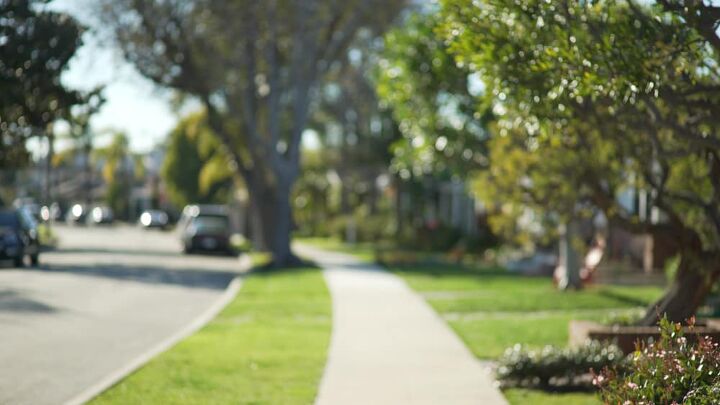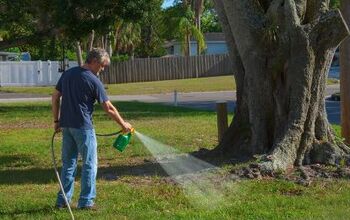Who Owns The Grass Between The Sidewalk And The Curb?

Property ownership can be far more complicated than it seems. When you buy a house, you not only get the house but the land on which the house comes. That includes the yard, driveway, and any areas designated by the deed.
The municipality generally owns the grass between the sidewalk and curb. Some areas require homeowners to split the cost of maintaining the grass between the sidewalk and the curb, but it varies. Private neighborhoods require the property owner to maintain that grass.
What is That Little Slab of Grass Between the Curb and Sidewalk?
For most residential properties, the layout is about the same. There is the plot of land in which the home sits. There is generally a front yard, back yard, and driveway. Those things can vary based on the plot of land, but that is the most common example.
In some residential areas, though, there is a little slab of grass that resides between the sidewalk and the curb. More often than not, that is referred to as a tree lawn. It is meant to provide a buffer between the street and sidewalk while also enhancing the curb appeal of the land.
What are Some of the Names for The Patch of Grass?
This may depend on where you live but there are some fairly common terms used to describe that patch. In most areas of the United States, they are referred to as tree lawns.
They are technically known as verges. A verge is a strip of grass or plants, even trees in some cases, that sit between the sidewalk and roadway. The terminology is regional and you will likely hear it called by a dozen different names as you venture throughout the country.
Who Owns the Tree Lawn?
While it may seem obvious that the property owner would own that little patch of grass, that may not necessarily be the case. The simple fact of the matter is that properties can be divided in odd manners. The surest way to find out who owns the tree lawn is to check with the city.
That said there are generally two explanations. In most cases, the municipality in which the property resides owns that space. In gated communities, that may not be the case.
The Municipality
For most residential spaces, the tree lawn belongs to the municipality. The marking of a property typically begins at the curb itself. That said, the tree lawn (and the sidewalk as well) generally belong to the municipality.
The not-so-funny part is that they don’t maintain or care for it (more on that later). So despite not even owning that little patch of grass, the care for it falls on the property owner. If you aren’t certain about whether not the municipality owns that space, you can check with city hall to find out.
Gated Communities
The most common exception to the aforementioned rule is with gated communities. They have different zoning specifications as compared to traditional residential neighborhoods. It is not uncommon for gated community property owners to own that space between the lawn and curb.
Make sure to check with your homeowner’s association. You can ask before purchasing the property or at anytime after. It doesn’t make an impact on property values and really doesn’t hold major importance, but it is nice to own a little extra space at the end of the day.
The Right of Way
There is actually a specific rule in place when it comes to the ownership of land by the community. This rule is called the right of way and, though it varies from community to community, there are a couple of basic rules of thumb that you can follow.
Many municipalities have a 50-foot right of way. That right of way is a declaration of ownership from the community from the centerline of the corresponding road. In some areas, that right of way may be 25-feet (typically smaller residential areas).
That right of way is in place to include the curb, tree lawn, and the sidewalk. Even when there is no sidewalk, the town generally has right of way to at least the first several feet of that given property. Things can get a little more complicated when there is no sidewalk, so checking community guidelines is advisable there.
Who is Responsible for Maintaining the Grass Between the Sidewalk and Curb?
Despite the fact that most property owners do not actually own that patch of grass, guess who has the task of upkeep? Quick hint: it isn’t the city. That’s right, despite not owning the grass between the curb and sidewalk, the property owner is responsible for its upkeep.
Typically speaking, all that is required is keeping the grass at specified city heights. Since you mow your lawn already, it is just a couple of extra passes to keep the tree lawn neat and clean. Still, it is almost laughable that the property owner doesn’t own that space but has to care for it.
Is the Sidewalk Public Property, too?
The sidewalk, as well as the road (which you probably knew), are also public property. They are meant to provide pathways for pedestrians to walk throughout these residential areas.
The good news is that the property owner is not responsible for the upkeep of the sidewalks. When there are major issues – cracking or missing chunks – it is up to the city to come out and fix the damage. Still, sidewalks with major damage can be unsightly for property owners and they may not get the type of expedited response that they were hoping for.
Related Questions
With greater clarification, you can know whether or not that little patch of land is yours or simply yours to care for. While the municipality typically owns it, that doesn’t mean that there are not other questions. Here are a few questions that users had relating to their property, tree lawn, and more.
Are the Sidewalk and Curb Considered Public or Private Property?The short answer is that it depends. For smaller suburbs and cities, particularly in the aforementioned residential areas, sidewalks are considered to be public property. That said, the upkeep and maintenance of the grass is up to the homeowner of the adjacent property.
Where the sidewalk becomes private property is in the aforementioned gated communities. Because there are different guidelines in place for these communities, they don’t adhere to the same set of ownership and rules.
Can I Remove or Change the Sidewalk in Front of my House?In most cases, the part of the sidewalk located at the front of a property runs in a longer line along that street. It could also be one that leads from the street to your home, depending on the location and layout of the property.
For the most part, the locality – whether it be a county, town, township, etc.) will have an easement on that sidewalk. So, while it is technically located in front of your home, you would not be able to remove the sidewalk or potentially replace it.
The general upkeep for the sidewalk falls on the homeowner. That is, they have the responsibility to keep it clean and neat. Should there be major structural issues with the concrete – cracking or missing chunks – then the responsibility would fall on the locality to make those repairs. Find out how to stop neighbors from blowing leaves in your yard.
Can I Be Sued if Someone Falls on the Sidewalk in Front of My House?Because of the locality’s ownership of the sidewalk, there is an assumption that they assume fault should someone fall and injure themselves. The unfortunate truth is that the homeowner is often considered at fault in instances of an injury.
This can be a bit murky. There needs to be definite proof that the homeowner was negligent in the care of the sidewalk. So, while it may obvious that owning the sidewalk would make the locality liable, that is just not so. Know your rights and responsibilities in the event of an accident in front of your home.
Related Articles

Ryan Womeldorf has more than a decade of experience writing. He loves to blog about construction, plumbing, and other home topics. Ryan also loves hockey and a lifelong Buffalo sports fan.
More by Ryan Womeldorf



























